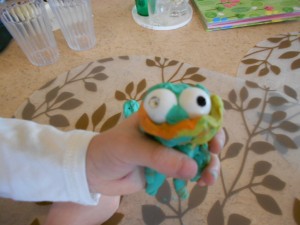Hands inside a puppet make both the puppet and learning come alive, helping with kindergarten readiness in many different ways. Puppets:
 stimulate lots of conversation. Children practice using the language patterns of each person having a turn to speak. Asking questions is a development skill and kids can ask their puppets questions and give the answers.
stimulate lots of conversation. Children practice using the language patterns of each person having a turn to speak. Asking questions is a development skill and kids can ask their puppets questions and give the answers.
- can help children see another’s point of view. The puppet may not like the same things as the child and the child explores this in the dialogue.
- encourage use of imagination. There’s lots of interaction with puppets, similar to interactions with friends and others.
- invite lots of movement and action, using both fine muscles and big muscles, too.
Puppets can be created from old socks, paper bags, popsicle sticks, fabric scraps, even small styrofoam containers. Although puppets usually go over the hand, rather than it, apparently this plasticine is a puppet. To extend your child’s play, you can ask the puppet’s name. You may want to ask other questions such as what it is doing, if it knows how to sing a song, it’s favorite color, how it is feeling, if it is scared of anything, or if it knows how to be a friend. You may want a turn being the puppet and can use various voices such as low, grumpy, happy, squeaky and very slow. Two or more puppets can have their own conversations for double the fun! Does your child like to play with puppets?
